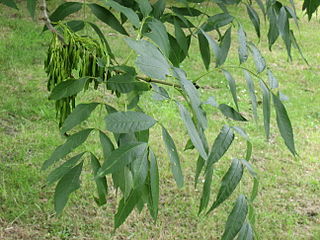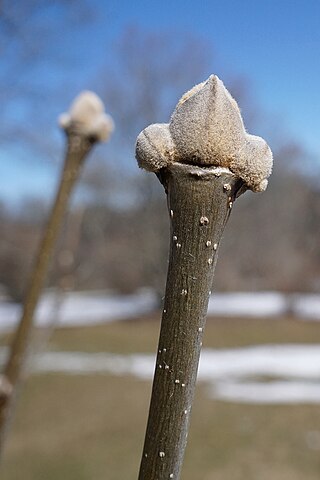
Trillium is a genus of about fifty flowering plant species in the family Melanthiaceae. Trillium species are native to temperate regions of North America and Asia, with the greatest diversity of species found in the southern Appalachian Mountains in the southeastern United States.

Fraxinus, commonly called ash, is a genus of plants in the olive and lilac family, Oleaceae, and comprises 45–65 species of usually medium-to-large trees, most of which are deciduous trees, although some subtropical species are evergreen trees. The genus is widespread throughout much of Europe, Asia, and North America.

Fraxinus americana, the white ash or American ash, is a fast-growing species of ash tree native to eastern and central North America.

Quercus muehlenbergii, the chinquapinoak, is a deciduous species of tree in the white oak group. The species was often called Quercus acuminata in older literature. Quercus muehlenbergii is native to eastern and central North America. It ranges from Vermont to Minnesota, south to the Florida panhandle, and west to New Mexico in the United States. In Canada it is only found in southern Ontario, and in Mexico it ranges from Coahuila south to Hidalgo.

Quercus bicolor, the swamp white oak, is a North American species of medium-sized trees in the beech family. It is a common element of America's north central and northeastern mixed forests. It can survive in a variety of habitats. It forms hybrids with bur oak where they occur together in the wild.

Fraxinus excelsior, known as the ash, or European ash or common ash to distinguish it from other types of ash, is a flowering plant species in the olive family Oleaceae. It is native throughout mainland Europe east to the Caucasus and Alborz mountains, and Great Britain and Ireland, the latter determining its western boundary. The northernmost location is in the Trondheimsfjord region of Norway. The species is widely cultivated and reportedly naturalised in New Zealand and in scattered locales in the United States and Canada.

Fraxinus pennsylvanica, the green ash or red ash, is a species of ash native to eastern and central North America, from Nova Scotia west to southeastern Alberta and eastern Colorado, south to northern Florida, and southwest to Oklahoma and eastern Texas. It has spread and become naturalized in much of the western United States and also in Europe from Spain to Russia.

Quercus lyrata, the overcup oak, is an oak in the white oak group. The common name, overcup oak, refers to its acorns that are mostly enclosed within the acorn cup. It is native to lowland wetlands in the eastern and south-central United States, in all the coastal states from New Jersey to Texas, inland as far as Oklahoma, Missouri, and Illinois. There are historical reports of it growing in Iowa, but the species appears to have been extirpated there. It is a slow-growing tree that often takes 25 to 30 years to mature. It has an estimated lifespan of 400 years.

Quercus arkansana, the Arkansas oak, is a species of oak tree. It is native to the southeastern United States. It is threatened by use of its habitat for pine plantations, clearing of land, and diebacks that may be caused by drought.
John Dransfield is an honorary research fellow and former head of palm research at the Royal Botanic Gardens, Kew, United Kingdom, as well as being an authority on the phylogenetic classification of palms.

Fraxinus hubeiensis is a species of ash native to Hubei province in China.

Hymenoscyphus fraxineus is an ascomycete fungus that causes ash dieback, a chronic fungal disease of ash trees in Europe characterised by leaf loss and crown dieback in infected trees. The fungus was first scientifically described in 2006 under the name Chalara fraxinea. Four years later it was discovered that Chalara fraxinea is the asexual (anamorphic) stage of a fungus that was subsequently named Hymenoscyphus pseudoalbidus and then renamed as Hymenoscyphus fraxineus.

CandidatusPhytoplasma fraxini is a species of phytoplasma, a specialized group of bacteria which lack a cell wall and attack the phloem of plants. This phytoplasma causes the diseases ash yellows and lilac witches' broom.

Fraxinus griffithii, the Himalayan ash or evergreen ash is a species of flowering tree. The natural habitat includes the Philippines, Indonesia, Vietnam, Myanmar, Taiwan, China, Bangladesh and India. This plant is commonly grown as an ornamental in Australia, where it is an invasive species.

Tiarella stolonifera is a species of flowering plant in the family Saxifragaceae. The specific name stolonifera means "spreading by stolons", an important characteristic of this species. Known as the creeping foamflower, it has the widest range of any species of Tiarella in eastern North America.
Fraxinus longicuspis, the taper-tip ash or Japanese ash, is a species of flowering plant in the family Oleaceae, native to the mountains of central and southern Japan. A deciduous tree, it is hardy to USDA zone 5. It is used as a street tree in a few cities around the world.
Fraxinus greggii, the littleleaf ash or Gregg's ash, is a species of flowering plant in the family Oleaceae, native to Texas and Mexico. A xerophytic shrub or scrubby tree reaching 6 m (20 ft), it is suitable for screens and containers. There is a cultivar, 'Libby Davison'.

Fraxinus paxiana is a species of flowering plant in the family Oleaceae, native to central and southern China. A tree reaching 20 m (66 ft), it is found in forested valley slopes, usually from 400 to 1,100 m above sea level. In the wild it is heavily infected with Hymenoscyphus fraxineus, the fungal pathogen that causes ash dieback, but shows little damage.
Fraxinus chiisanensis, the Jirisan ash, is a species of flowering plant in the family Oleaceae, native to South Korea. With only about 20,000 mature trees found in nine locations, it is assessed as Endangered due to severe population fragmentation, and some logging pressure. In spite of its Endangered status, it is still dominant in those streamside mountain forests where it does occur.
Fraxinus papillosa, the Chihuahuan ash, is a species of flowering plant in the family Oleaceae, native to the deserts of Mexico and the southwestern United States. A small tree, it usually is found growing in canyon bottoms and on north-facing slopes.
















